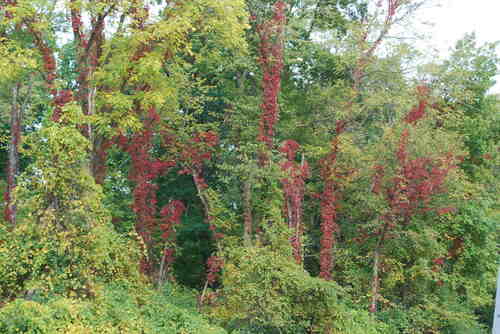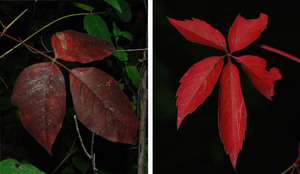Virginia Creeper - A native vine with powerful fall color

Virginia Creeper (Parthenocissus quinquefolia) climbs up trees in a forest, adding some columnar red to a deep woods.
Rick Meader | Contributor
If I told you to add to your landscape a vine that climbs trees and sometimes forms a ground cover, has berries that birds love, has multiple leaflets (sometimes three), is frequently found in woods and woods edges, and turns red in the fall, you might be intrigued, but you also might think I was telling you to plant poison ivy (Taxus radicans). But, in fact, that also describes Virginia Creeper (Parthenocissus quinquefolia), a really nice plant that is showing its true red/burgundy colors on trees throughout southeastern Michigan right now. Before you kill it, thinking its poison ivy, let’s learn more about it and see if it’s something you’d like to have in your yard.
Virginia Creeper (also called Woodbine by some) is a member of the same genus as non-native Boston Ivy (Parthenocissus tricuspidata) which is found on many of the ivy-covered walls around the University of Michigan campus, but is quite different in appearance.
Virginia Creeper typically has five leaflets in a palm-like arrangement, ranging from three to 8 inches across. It may be a ground cover, or may climb high up on a building or wall with the help of small adhesive disks that adhere to a surface. (This method of adherence doesn’t damage the surface, as its roots don’t penetrate the surface).
Poison ivy adheres to a surface through lots of little roots extending from the vine and only has three leaflets. Also, the leaflets of Virginia creeper have many more teeth along their edge than poison ivy, which has larger and fewer serrations along its leaf edges. Virginia creeper’s berries are dark purple, while poison ivy’s berries are white. Both plants’ berries are loved by birds.
The pluses of Virginia Creeper are: It forms a nice cover on a wall or fence, which can serve as a cooling mechanism for masonry buildings on which it attaches; it provides a spectacular color display at this time of year, especially when the sun shines brightly on it on clear fall day; it can form a loose ground cover, allowing some other plants to co-exist, but removing some vacant soil for non-natives to become established; it’s a hardy, quick-growing plant once it becomes established; and it’s a food source for wildlife, especially birds.

While they may look alike at first glance, Poison Ivy (Taxus radicans) and Virginia Creeper are actually quite different. Poison Ivy has 3 broader leaflets with fewer toothed serrations along their edges. Virginia Creeper has 5 narrower leaflets with pointed teeth along the edges. Remember 3 - BAD, 5 - OKAY (but both are native)!
Rick Meader | Contributor
There are also some negatives to the species that I have to pass along: It can become quite aggressive and cover plants that you might not want covered, and it can also cause skin irritation for some people, although that isn’t as widespread as the effects of poison ivy. All things considered, it’s a nice addition to many native plantings that might require a vigilant eye to keep it where you want it.
Virginia Creeper is native to the eastern two-thirds of North America and most Michigan counties. Given its range, it’s natural to assume that Native Americans had many uses for it, and they did. Uses ranged from a treatment for yellow jaundice and to counteract poison sumac, to reducing swellings and for food. Additionally, the berries were used to create a pink paint for skin and feathers worn in a war dance, among other uses.
We have it in our yard, and while it took a little while to get established, it’s now covering a lot of our decrepit wood fence and is climbing up some Siberian elms, to give them some redeeming value as a palette on which Virginia is creeping to paint red. This is a native plant, though, that I don’t feel too bad in pulling on occasion to keep its aggressive habits in check.
This week, the asters (Smooth, New England, Heart-leaf, Arrow-leaf, Heath, Short’s and Calico) and goldenrods (Zig Zag and Bluestem) are all blooming their little hearts out, much to the delight of hundreds of bees (some big, some tiny), and Green-headed Coneflower and Brown-eyed Susan also continue to hang on in bloom. Berries also contribute to the fall riot of colors, and in our yard, the orange berries of Wild Coffee/Horse Gentian, the red fruits of Jack-in-the-pulpit, Spicebush and false Solomon’s Seal, and the black fruits of true Solomon’s Seal all add some extra color to our yard. It’s a great time of year for color, so look in your yard and beyond for some native eye candy.
Rick Meader is a local landscape architect with a special interest in all things natural, including creating designs that include a lot of native plants (and the critters they support). You can contact him at yourland1824@gmail.com.


Comments
Rick Meader
Fri, Oct 5, 2012 : 2:27 a.m.
It might be Common cinquefoil (Potentilla simplex) if it's a low-growing vine with yellow flowers in the summer, and a total leaf span of 2-3", but then again it might not. If you can e-mail me a picture of it at yourland1824@gmail.com, I'll give it the old college try.
RunsWithScissors
Tue, Oct 2, 2012 : 11:36 a.m.
I have something that looks & grows like Virginia Creeper (5 leaflets with serrated edges) but doesn't turn red in the fall. What might it be?